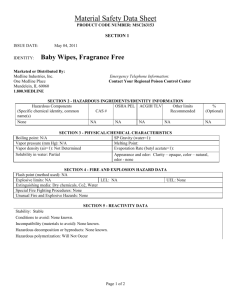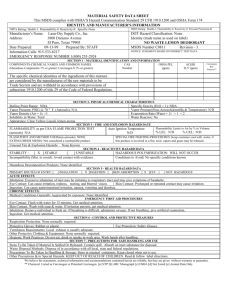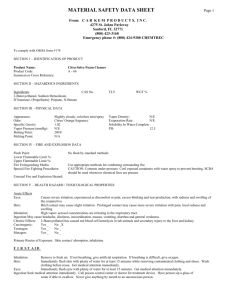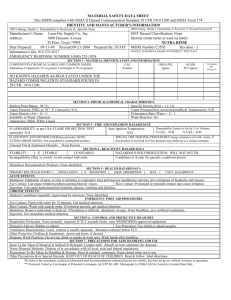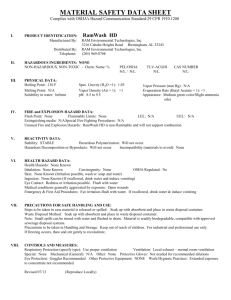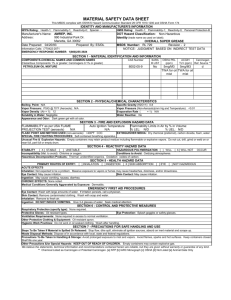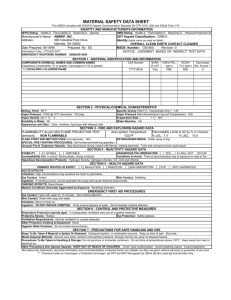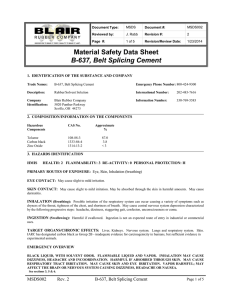material safety data sheet
advertisement
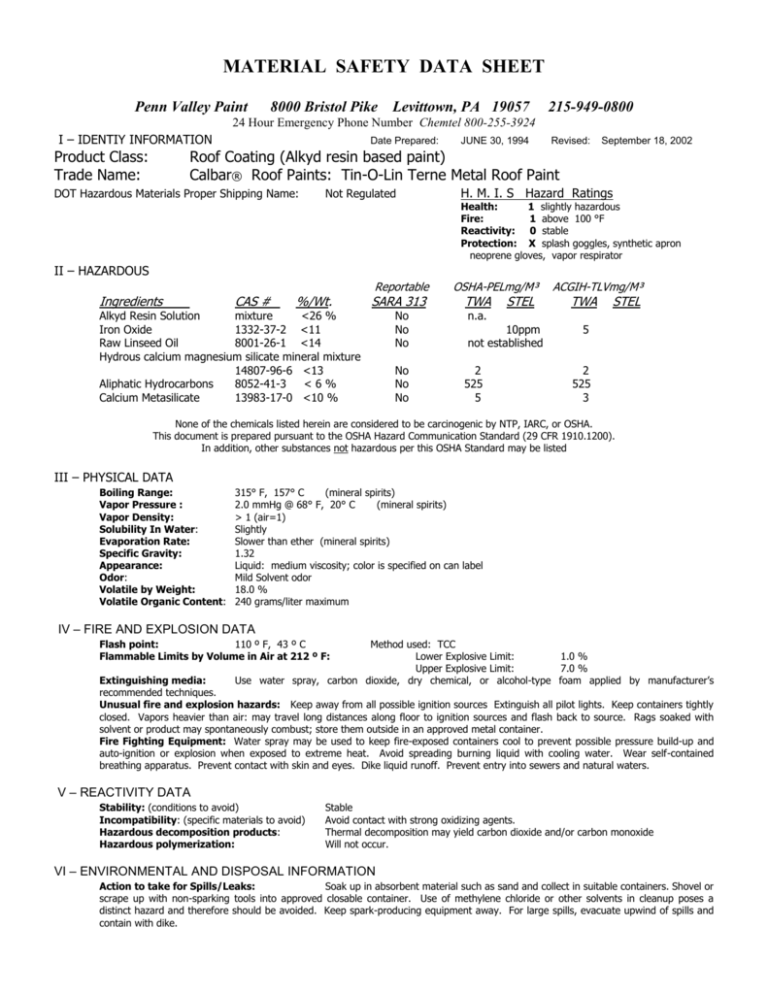
MATERIAL SAFETY DATA SHEET Penn Valley Paint 8000 Bristol Pike Levittown, PA 19057 215-949-0800 24 Hour Emergency Phone Number Chemtel 800-255-3924 I – IDENTIY INFORMATION Product Class: Trade Name: Date Prepared: JUNE 30, 1994 Revised: September 18, 2002 Roof Coating (Alkyd resin based paint) Calbar® Roof Paints: Tin-O-Lin Terne Metal Roof Paint DOT Hazardous Materials Proper Shipping Name: Not Regulated H. M. I. S Hazard Ratings Health: 1 slightly hazardous Fire: 1 above 100 °F Reactivity: 0 stable Protection: X splash goggles, synthetic apron neoprene gloves, vapor respirator II – HAZARDOUS Ingredients CAS # %/Wt. Alkyd Resin Solution mixture <26 % Iron Oxide 1332-37-2 <11 Raw Linseed Oil 8001-26-1 <14 Hydrous calcium magnesium silicate mineral mixture 14807-96-6 <13 Aliphatic Hydrocarbons 8052-41-3 <6% Calcium Metasilicate 13983-17-0 <10 % Reportable SARA 313 No No No No No No OSHA-PELmg/M³ TWA n.a. STEL 10ppm not established 2 525 5 ACGIH-TLVmg/M³ TWA STEL 5 2 525 3 None of the chemicals listed herein are considered to be carcinogenic by NTP, IARC, or OSHA. This document is prepared pursuant to the OSHA Hazard Communication Standard (29 CFR 1910.1200). In addition, other substances not hazardous per this OSHA Standard may be listed III – PHYSICAL DATA Boiling Range: Vapor Pressure : Vapor Density: Solubility In Water: Evaporation Rate: Specific Gravity: Appearance: Odor: Volatile by Weight: Volatile Organic Content: 315° F, 157° C (mineral spirits) 2.0 mmHg @ 68° F, 20° C (mineral spirits) > 1 (air=1) Slightly Slower than ether (mineral spirits) 1.32 Liquid: medium viscosity; color is specified on can label Mild Solvent odor 18.0 % 240 grams/liter maximum IV – FIRE AND EXPLOSION DATA Flash point: 110 º F, 43 º C Flammable Limits by Volume in Air at 212 º F: Method used: TCC Lower Explosive Limit: 1.0 % Upper Explosive Limit: 7.0 % Use water spray, carbon dioxide, dry chemical, or alcohol-type foam applied by manufacturer’s Extinguishing media: recommended techniques. Unusual fire and explosion hazards: Keep away from all possible ignition sources Extinguish all pilot lights. Keep containers tightly closed. Vapors heavier than air: may travel long distances along floor to ignition sources and flash back to source. Rags soaked with solvent or product may spontaneously combust; store them outside in an approved metal container. Fire Fighting Equipment: Water spray may be used to keep fire-exposed containers cool to prevent possible pressure build-up and auto-ignition or explosion when exposed to extreme heat. Avoid spreading burning liquid with cooling water. Wear self-contained breathing apparatus. Prevent contact with skin and eyes. Dike liquid runoff. Prevent entry into sewers and natural waters. V – REACTIVITY DATA Stability: (conditions to avoid) Incompatibility: (specific materials to avoid) Hazardous decomposition products: Hazardous polymerization: Stable Avoid contact with strong oxidizing agents. Thermal decomposition may yield carbon dioxide and/or carbon monoxide Will not occur. VI – ENVIRONMENTAL AND DISPOSAL INFORMATION Action to take for Spills/Leaks: Soak up in absorbent material such as sand and collect in suitable containers. Shovel or scrape up with non-sparking tools into approved closable container. Use of methylene chloride or other solvents in cleanup poses a distinct hazard and therefore should be avoided. Keep spark-producing equipment away. For large spills, evacuate upwind of spills and contain with dike. MSDS – Roof Coating - Page Two VII – HEALTH HAZARD DATA Primary routes of exposure: Skin contact, inhalation. Eye: Exposure to liquid or vapor may cause eye irritation. Symptoms may include burning, tearing and redness. Skin Contact: Essentially nonirritating to skin on contact. Repeated exposure may cause skin irritation. Material may stick to skin causing irritation upon removal. May cause skin sensitization in susceptible individuals. Immediately remove wet contaminated clothing to avoid flammability hazard. Wash clothing before reuse. Skin absorption: A single prolonged skin exposure is not likely to result in absorption of harmful amounts. Repeated skin exposure may result in absorption of harmful amounts. Ingestion: Can cause gastrointestinal irritation, nausea, vomiting and diarrhea. Aspiration of material into lungs can cause chemical pneumontis that can be fatal. Inhalation: Excessive exposure may cause irritation to upper respiratory tract and lungs. Excessive exposure may cause central nervous system effects. Overexposure effects: Chronic exposure may cause respiratory tract irritation with nasopharyngitis and laryngitis. Medical conditions aggravated by exposure: Respiratory and skin conditions. VIII – FIRST AID Eyes: Irrigate immediately with water for at least 5 minutes. Skin: Wash off in flowing water or shower. Wash contaminated clothing before reuse. Ingestion: Do not induce vomiting. Call a physician. Inhalation: If ill effects occur, remove to fresh air. If not breathing, give artificial respiration, preferably mouth-tomouth. If breathing is difficult, give oxygen. Call a physician. Note to physician: No specific antidote. Supportive care. Treatment based on judgment of the physician is response to reactions of the patient. IX – HANDLING PRECAUTIONS Exposure guidelines: See Section II Ventilation: Provide general and/or local exhaust ventilation to control airborne levels below the exposure guideline. Avoid breathing vapor, mist or spray. Respiratory protection: Atmospheric levels should be maintained below the exposure guideline. When respiratory protection is required for certain operations, use an approved air purifying respirator (NIOSH/MSHA TC 23c or equal). For emergency and other conditions where the exposure guideline may be greatly exceeded, use an approved positive pressure self-contained breathing apparatus. Skin protection: Use impervious gloves when prolonged or frequently repeated contact could occur. Wash thoroughly after handling and before eating, drinking or smoking. Eye protection: Use splash goggles. X – ADDITIONAL INFORMATON: REGULATORY REQUIREMENTS SARA Hazard category: This product has been reviewed according to the EPA “Hazard Categories’ promulgated under Section 311 and 312 of the Superfund Amendment and Reauthorization Act of 1986 (SARA Title III) and is considered, under applicable definitions, to meet the following categories: An immediate (acute) health hazard – NO: A delayed (chronic) health hazard – YES: A fire hazard – YES: A reactive hazard – NO. This product does contain a toxic chemical for routine annual “toxic chemical release reporting” under Section 313. Pennsylvania Right-to-Know Act: n.a. Special precautions to be taken in handling and storage: Material is combustible and should be stored and handled in grounded equipment when handled in containers > 5 gallons. Avoid sources of ignition. Extinguish pilot lights. Abbreviations ACGIH - American Conference of Governmental Industrial Hygienists OSHA CAS - Chemical Abstracts Service MM IARC - International Agency for Research on Cancer MPPCF LEL - Lower Explosive Limits MSHA MG CU M -Milligram per Cubic Meter N.A. N/E - Not Established PEL NIOSH - National Institute of Occupational Safety and Health PPM OSHA - Occupational Safety and Health Administration RECM TCC / PM - Tag – Closed Cap / Pensky – Martin TLV UEL - Occupational Safety and Health Administration Millimeters Millions of Particles per Cubic Foot Mines Safety and Health Administration Not Applicable Permissible Exposure Level Parts per Million Recommended Threshold Limit Values Upper Explosive Limits The information contained herein is based on data considered to be accurate. Penn Valley Paint makes no warranties express or implied and assumes no responsibility for the accuracy or completeness of the data. Penn Valley Paint further assumes no responsibility for personal injury or property damage to customers, users, or third parties caused by this material. Such customers or users assume all risks associated with the use of this material. 215-949-0800. Material Safety Data Sheet: Calbar® Roof Paints – Shower-Proof ™ & Tin-O-Lin™ Msds/roof1-2
